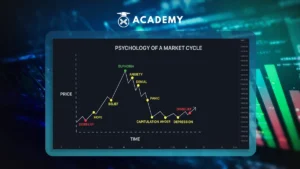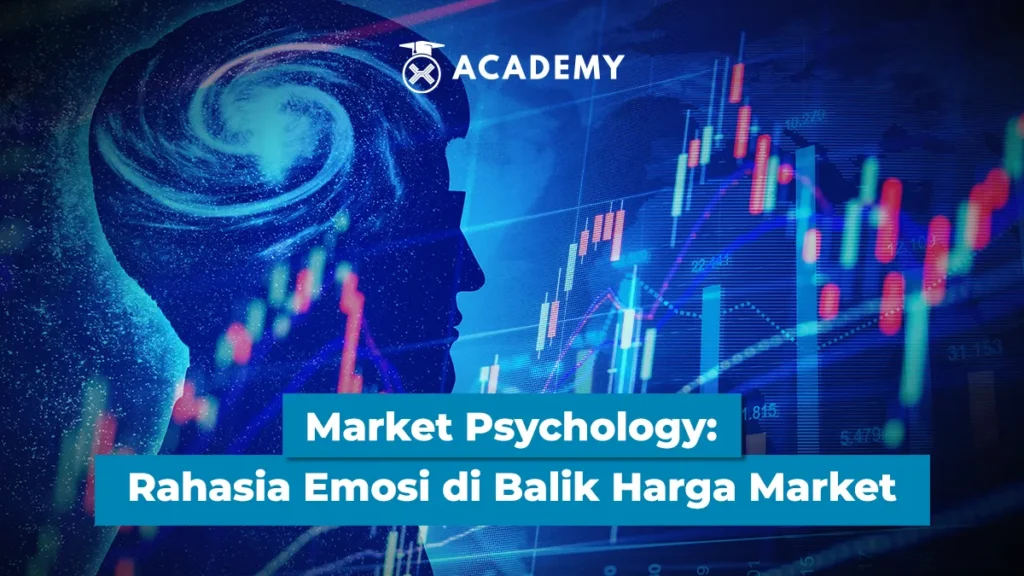Have you ever seen the price of a crypto asset suddenly rise or fall sharply, even though there was no significant news to explain it?
Or perhaps you witnessed the market panic and massive selling, even though the asset’s fundamentals were still sound?
This is where market psychology plays a crucial role. It’s not just about charts or numbers, but collective emotions like fear, greed, euphoria, and panic that often move the market faster than logic.
If you want to become more adept at reading market movements, understanding how the mindset of market participants works en masse is crucial.
This article will discuss market psychology in depth so you can make more rational trading decisions and avoid being easily swayed by the current.
What is Market Psychology?

Market psychology refers to the collective sentiment and behavior of market participants over a specific period.
This term is often used by analysts and financial media to explain price movements that appear illogical or inconsistent with fundamental data such as financial reports or macroeconomic conditions.
Therefore, when asset prices spike or plummet drastically without any compelling data-based reason, psychological factors are likely at play.
Unlike trader psychology, which focuses on individuals, market psychology describes the collective emotions and perceptions of the entire market.
Emotions such as fear, greed, euphoria, and excessive expectations often drive the market into cycles of “risk-on” (risk-taking) and “risk-off” (risk-avoidance).
For example, when the majority of investors suddenly lose confidence in the economy, stock prices can plummet even if the company’s performance is still good.
This situation is usually exacerbated by the rapid flow of information from the media, known as the CNN effect, where intensive news coverage influences broader market sentiment.
In economics, this is also called animal spirits, a term coined by theorist John Maynard Keynes to describe the spontaneous human impulse to act without a clear rational basis.
Market psychology is a key element in the behavioral finance approach, which emphasizes that investors often make decisions influenced by emotions and biases, rather than solely by logic or rational analysis.
This contradicts the efficient market hypothesis, which assumes all market participants are always rational. Therefore, understanding market psychology is a crucial skill in the world of trading and investing.
By understanding how mass emotions form and change, you can read market direction more rationally and avoid being easily swayed.
In practice, there are several quantitative indicators that can help you read market sentiment, such as the VIX (volatility index), the high-low index, and the bullish percentage index.
These indicators help detect changes in sentiment before major movements occur. Market psychology also forms the basis of technical analysis because price and volume patterns often reflect the collective behavior of market participants.
Therefore, understanding market psychology will greatly assist you in reading signals and opportunities more astutely.
You might also be interested in this: Understanding the Fear and Greed Index Sentiment for Crypto and Stocks
Collective Emotions That Drive the Market
Financial markets are not always driven by data or logic alone. Often, the collective emotions of market participants are the primary factor behind the fluctuations in asset prices.
There are four primary emotions that most frequently emerge and broadly influence investment decisions:
1. Fear
When concerns about losses arise, whether due to negative news or global sentiment, many investors rush to sell assets. This mass selling can cause prices to drop sharply in a short period of time.
2. Greed
The desire for large profits in a short period of time often triggers greedy behavior. This occurs when many people buy simply out of fear of missing out (FOMO), causing prices to soar without a solid basis.
3. Hope
Excessive optimism causes some traders to hold on to losing positions, hoping the market will soon reverse direction. However, objectively, the exit signal is already clear.
4. Regret
Feelings of regret over previous decisions, such as not buying when prices were low, can lead to impulsive decisions. For example, entering the market at the wrong time simply because you want to “make up for your mistakes.”
These emotions not only influence individual decisions but can also shape the collective direction of the market. In many cases, they create short-term trends, form price bubbles, or even trigger sudden crashes.
Therefore, understanding the dynamics of market emotions is crucial to avoid being easily swayed and to make more rational decisions.
Market Psychology Cycle: From Euphoria to Panic
Market movements are not always driven by data or rational analysis, but also by recurring patterns of collective emotions.
The market psychology cycle illustrates how market participant sentiment—from excessive optimism to panic—can drive extreme price movements.
This pattern indicates a transition in mass emotions that significantly influences market direction. Generally, this cycle is divided into four main phases:
1. Euphoria
At this stage, optimism peaks and prices rise sharply. Many people feel they are “guaranteed to profit” and begin to enter the market en masse. This is the beginning of a price bubble, when valuations no longer reflect real conditions.
2. Confidence
After a significant increase, prices tend to stabilize at high levels. Market participants begin to feel confident that the positive trend will continue. Many consider this the “new normal,” when in fact the market is beginning to become vulnerable.
3. Panic
Signs of a downturn begin to appear, accompanied by negative news or profit-taking. Investors begin to panic and sell their assets, causing prices to drop sharply in a short period of time.
4. Collapse/Capitulation
In this phase, the majority of market participants surrender. Massive selling occurs, prices plummet, and fear grips the market. Many exit with significant losses.
Interestingly, many novice investors enter during the euphoria, when prices are already high, and exit during the panic, when prices are falling.
In contrast, experienced investors take the opposite approach: they exercise caution during the euphoria and begin buying during market panic.
Another interesting article for you: Apa Itu Bull Run dalam Crypto? Penjelasan, Sejarah & Simbolnya
Real-Life Examples of Market Psychology in the Crypto World
Market psychology is particularly evident in the crypto world, which tends to be more volatile than traditional markets. The past few years have provided vivid examples of how collective emotions shape market direction, including the following:
1. 2021 Bull Run – Euphoria Phase
2021 saw the crypto market reach its peak of euphoria. Bitcoin hit an all-time high, and altcoins also surged dramatically.
Many people, including new investors, flocked to the market due to fear of missing out (FOMO).
The narrative that “crypto is the future” was heard everywhere, and almost all assets rose regardless of quality. Rationality began to be abandoned, replaced by the belief that prices would only continue to rise.
2. 2022 Bear Market – Fear and Capitulation Phase
After a significant rise, the market began to experience a sharp correction. Sentiment shifted drastically to pessimism. Bitcoin and altcoin prices plummeted, with some dropping more than 80% from their peaks.
Fear then began to dominate the market. Many investors who were previously optimistic began selling their assets at a loss.
A mass capitulation occurred, when the majority of investors gave up and exited the market due to a loss of confidence. This was the phase when the market felt its darkest, and hope was almost gone.
3. Rebound 2023—2024 – The Hope and Greed Phase
Entering 2023 and 2024, the market began to show signs of recovery. Prices began to rise slowly, and investors returned in the hope that the positive trend would continue.
The media began reporting positive developments, and crypto projects regained attention. In this phase, a combination of hope and greed began to form.
Some investors who had previously lost money tried to recoup their losses, while new investors jumped back in, seeing the opportunity for quick profits.
By understanding these emotional patterns, you can more accurately assess the market’s position. Instead of following the crowd when everyone is euphoric, a wiser strategy is to take positions when the majority is still hesitant.
This is the essence of understanding market psychology: not just following trends, but also reading collective emotions and making decisions with a cool head.
Market Psychology Reading Tools

Market psychology is indeed abstract because it involves mass emotions and perceptions. However, there are several tools you can use to more accurately read market sentiment.
While they can’t provide certainty, these tools are useful as a guide for making more rational decisions, including:
1. Fear & Greed Index (Bitcoin only)
This index shows the extent to which the crypto market is dominated by fear or greed. Low numbers indicate fear dominance (potentially low prices), while high numbers indicate euphoria (potentially overly optimistic markets).
2. Volume Analysis
By looking at transaction volume, you can assess the strength of buying or selling interest. High volume when prices are rising indicates market confidence, while high volume when prices are falling can indicate strong selling pressure.
3. Social Media Sentiment
Opinions and conversations on platforms like Twitter or Reddit often reflect the collective feelings of market participants. Spikes in certain keywords can signal a change in sentiment, either toward optimism or fear.
4. Candlestick Patterns and Technical Reversal Signals
Candlestick formations and technical indicators such as RSI, MACD, or support-resistance can help you identify potential trend reversals, which are often related to changes in market sentiment.
It’s important to remember that none of these tools are absolute predictors. Its function is to serve as a guide for reading the direction of collective market sentiment, so you don’t make decisions based solely on instinct or following the crowd.
Still on this topic, also check out: What is FOMO in the Crypto World? How to Avoid It?
How to Avoid Market Psychology Traps
In the world of trading and investing, collective market emotions can become a trap if you don’t manage them well. Therefore, it’s important to have a disciplined and rational approach.
Here are some steps that can help you remain objective, including:
1. Avoid FOMO (Fear of Missing Out)
The fear of missing out often arises when prices are rising rapidly. However, buying an asset simply because others are rushing in can lead to you entering at the peak price. Always remember that impulsive decisions rarely end well.
2. Create an Entry and Exit Plan Before Buying
Determine from the start when you will buy and at what price you will sell. With a clear plan, you won’t be tempted to adjust your strategy amid volatile market conditions.
3. Stay Disciplined with Your Strategy
Having a strategy isn’t enough. What’s important is implementing it consistently. Avoid changing direction just because the market moves against your expectations for a day or two.
4. Don’t Follow the Crowd Without Logic
Mass movements can be tempting, but they don’t always mean they’re right. Make decisions based on analysis, not social pressure or short-term trends.
5. Evaluate Your Positions Regularly
Regularly reviewing your portfolio can help you see if your strategy is still relevant. It also prevents you from holding on to losing positions too long just because you’re hoping.
Essentially, market psychology is powerful, but it’s not something to be afraid of. If you can observe it calmly and avoid getting carried away, it can actually be a strategic advantage in decision-making.
CONCLUSION: Collective Emotions = The Market’s Hidden Power
So, that was an interesting discussion about Market Psychology, which you can read in full at the INDODAX Academy.
In conclusion, the financial market isn’t just about numbers, charts, and indicators. Behind all of that lies a powerful force that often goes unnoticed: collective emotions.
When millions of market participants react to news, rumors, or trends, psychological currents are created that can move prices drastically, far beyond logic or fundamentals.
By understanding market psychology, you can read the direction of market movements more clearly. You won’t be easily carried away by euphoria when prices rise, or panic when the market falls.
Instead, you can make decisions with a cool head, based on rational strategies.
Ultimately, understanding the market isn’t just about reading charts, but also about understanding how the market thinks collectively.
Therein lies the hidden power that can make you a wiser and more adaptive trader or investor.
Oh, and besides broadening your investment horizons, you can also stay updated with the latest crypto news and monitor digital asset price movements directly on the INDODAX Market. Don’t forget to activate notifications to stay up-to-date with the latest information about digital assets and blockchain technology, only on the INDODAX Academy.
You can also follow our latest news via Google News for faster and more reliable access to information. For an easy and secure trading experience, download the best crypto app from INDODAX on the App Store or Google Play Store.
Maximize your crypto assets with the INDODAX Earn feature, a practical way to earn passive income from your savings.
Follow us on social media here: Instagram, X, YouTube & Telegram
FAQ
1.What is market psychology?
Market psychology is the collective behavior and emotions that influence price movements in the market.
2.How is it different from trader psychology?
Market psychology focuses on all market participants, while trader psychology focuses on individual emotions.
3.What are the dominant emotions in market psychology?
Fear, greed, hope, and regret — all four significantly influence market direction.
4.What are the benefits of understanding market psychology?
It can help you trade more rationally, avoid FOMO, and enter the market at the right time.
5.Can market psychology be measured?
Yes, through indicators such as the Fear & Greed Index, volume analysis, and social media sentiment.
Author: Boy





 Polkadot 9.23%
Polkadot 9.23%
 BNB 0.57%
BNB 0.57%
 Solana 4.89%
Solana 4.89%
 Ethereum 2.37%
Ethereum 2.37%
 Cardano 1.22%
Cardano 1.22%
 Polygon Ecosystem Token 2.17%
Polygon Ecosystem Token 2.17%
 Tron 2.83%
Tron 2.83%
 Market
Market


